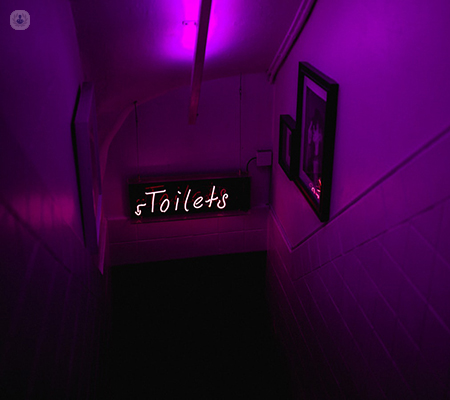How to tell if you’ve got cystitis
Written by:Cystitis is quite simply inconvenient, from the burning sensation when trying to urinate to sitting on the toilet in utter frustration. Sometimes, however, the discomfort of trying to empty the bladder could be a symptom of another complex nerve condition such as irritable bowel syndrome or diverticulitis, which has been mistaken as a UTI. Fortunately, expert urologist Mr Keng Jin Ng is on hand to explain how to differentiate between cystitis or whether it's something else…

What are the symptoms of cystitis?
Symptoms of cystitis are primarily burning sensations in the water passage (urethra). There are 2 distinct types of burning discomfort, which are:
1. the sensation of passing “hot water” or “razor blades” throughout the stream, which is related to bacterial cystitis.
2. A sensation of "pulling, squeezing, pinching or even “stabbing” before passing urine, which returns towards the end of passing urine, is related to interstitial cystitis. Patients tend to have a slight relief of the symptoms for that few seconds while passing urine.
Why do some women confuse cystitis with other conditions?
Cystitis is often confused with other conditions due to the complex nerve connections. The bladder is wired up by nerves that also supply the bowels and the muscles of the lower back and groin. In severe cystitis, the electric pulses from the bladder can short-circuit to the bowels causing irritable bowel symptoms such as bloating, constipation and intermittent loose motions. The electric pulses can also short-circuit to the muscles to cramp up the lower back causing severe backache or cramp up the groin and thigh muscles, causing severe pain. Hence, some patients were misdiagnosed with irritable bowel syndrome (IBS).
What are other conditions that cystitis can be confused with?
Pelvic pain can also be so severe, leading to the misdiagnosis of appendicitis or diverticulitis. Electric pulses of interstitial cystitis can also cause spasm of the internal pelvic muscle, leading to painful sexual intercourse. It can, therefore, be confused with sexually transmitted pelvic inflammatory disease (PID), or skin conditions such as vulvar lichen sclerosis (VLS). Cystitis can also be confused with endometriosis as the pelvic pain is often worse around the time of menstruation. This is because the base of the bladder and the urethra contain oestrogen receptors which respond to female hormones. Typically, the patient's pelvic pain would be worse a few days leading up to the start of the menstrual period.
How is cystitis treated?
Both types of cystitis can be treated effectively. Bacterial cystitis can cause scarring of the water passage leading to inefficient bladder emptying. So dirty bacteria cannot be flushed out of the bladder effectively. This, in turn, leads to recurrent bacterial infection, a vicious cycle. The urethra, therefore, needs to be stretched back to normal calibre by a minor operation under general anaesthesia called urethral dilatation. Interstitial cystitis is a much more complex condition.
There are several faults that need to be repaired. The cracks in the lining of the bladder need to be patched up with special medicine (such as chondroitin sulphate and hyaluronic acid) to allow the deeper nerve endings to settle so that the electric pulses do not short-circuit to the bowels and the pelvic muscles. There are also oral tablets to calm the nerves and relax the bladder muscle to help with the overall treatment. Once cured, the bladder will be good as new.
Is it true that cranberries can help with cystitis?
Cranberry extract can help prevent bacterial cystitis but does not treat interstitial cystitis. Cranberry extract such as d-mannose can prevent the "arms" (Type I Fimbriae) of E. coli from clinging on to the bladder lining causing bacterial cystitis. Another cranberry extract such as pro-anthocyanins (PAC) can block both the "arms" and "legs"(P pili) of E. coli so that the bacteria can be easily flushed out of the bladder. Hence, preventing bacterial cystitis. Blocking the p pili is particularly important in preventing the bacteria from reaching the kidney, causing kidney infection (pyelonephritis).


